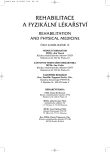-
Medical journals
- Career
Effect of Musculus Levator Scapulae on Lordosis of Cervical Spine
Authors: J. Čemusová; D. Pavlů; D. Pánek; K. Černíková
Authors‘ workplace: Katedra fyzioterapie, FTVS UK, Praha vedoucí katedry doc. PaedDr. D. Pavlů, CSc.
Published in: Rehabil. fyz. Lék., 15, 2008, No. 4, pp. 159-162.
Category: Original Papers
Overview
Musculus levator scapulae is the muscle with hardly defined function. It is hard to say if it is a muscle with more motional or stabilized function. In the article there is a description of the main shape and functional characteristic of this muscle. MR imaging of cervical spine was performed and transformed into the graphical program Amira. These images are from three people with different configuration of cervical spine. The result is a graphical picture of musculus levator scapulae of human body with physiologic, lordotic and flat configuration of cervical region. There is stated volume and area surface diameter of this muscle. Influence of musculus levator scapulae to the shape of the cervical region is possible to see visually from pictures and also from volume and surface area diameters.
Key words:
musculus levator scapulae, shape characteristic, modeling, cervical region
Sources
1. BOTTINELLI, R., REGIANNI, C. Human sceletal muscle fibres: molecular and functional diversity. Progress in biophysics and molecular biology, 2000, sv. 73.
2. BURKE, R. E., LEVENIE, D. N., ZAJAC, F. E.: Mammalian motor units: physiological-histochemical correlation in three types in cat gastrocnemius. Science, 1971, s. 709-712.
3. ČEMUSOVÁ, J.: Svalová dysbalance krčního regionu. Rehabilitace a fyzikální lékařství, 2006, 4.
4. ČEMUSOVÁ, J.: Vliv svalového napětí na tvar krčního regionu. Dizertační práce. Praha, 2008.
5. ČIHÁK, R.: Anatomie I. Praha, Grada Publishing, 2001. ISBN 80-7169-970-5.
6. DYLEVSKÝ, I.: Obecná kineziologie. Praha, Grada Publishing, 2007. ISBN 978-80-247-1649-7.
7. GRIM, M., DRUGA, R.: Základy anatomie 1. Obecná anatomie a pohybový systém. Praha, Galén, 2001. ISBN 80-7262-112-2.
8. GROSS, J. M.: Vyšetření pohybového aparátu. Překlad druhého vydání. Praha, Triton, 2005. ISBN 80-7254-720-8.
9. GROSS, J. M., FETTO J., ROSEN, E.: Vyšetření pohybového aparátu. Překlad druhého vydání. Praha, Triton, 2005. ISBN 80-7254-720-8.
10. HERMACHOVÁ, H.: O svalovém napětí a jeho ovlivnění ve fyzioterapii. Rehabilitace a fyzikální lékařství, 1999, 3, ISSN1211-2658.
11. JANDA, V.: Základy kliniky funkčních (neparetických) hybných poruch. Brno, Ústav pro další vzdělávání středních zdravotnických pracovníků, 1984. ISBN 57-855-84.
12. JANDA,V.: Funkční svalový test. Grada Publishing, 1996. ISBN 80-7169-200-5.
13. JANDA, V.: Differential diagnostics of muscle tone in respect of inhibitory techniques. Back pain, an international review J. K. Paterson and L. Burn. London, Ed. Kluwe Acad. Press, 1999.
14. JARKOVSKÁ, D., MARTÍNEK, J.: Histologie. Praha, Karolinum, 1997.
15. KOLÁŘ, P.: Senzomotorická podstata posturálních funkcí jako základ pro nové přístupy ve fyzioterapii II. Rehabilitace a fyzikální lékařství, 1998, 4. ISSN 1211-2658.
16. KOLÁŘ, P.: Systematizace svalových dysbalancí z pohledu vývojové kineziologie. Rehabilitace a fyzikální lékařství, 2001,4, s. 152-164. ISSN 1211-2658.
17. KONRÁDOVÁ, V., UHLÍK, J., VAJNER, L.: Funkční histologie. Jinočany, H&J Jinočany, 2000. ISBN 80-86022-80-3.
18. LEWIT, K.: Manipulační léčba v myoskeletální medicíně. Praha, Sdělovací technika, s.r.o, s ČLS JEP, 2003. ISBN 80-86645-04-5.
19. LIEBENSON, C:. Rehabilitaion of the spine. Los Angeles, Kalifornia, Lippincott, 1996.
20. MARŠÍK, F., DVOŘÁK, I.: Biotermodynamika. 2. vydání. Praha, Academia, 1998. ISBN 80-200-0664-8.
21. PANJABI, M., WHITE, A. A.: Biomechanics inthe musculosceletal system. USA, Churchil Livingstone, 2001. ISBN 0-443-0658-3.
22. RASCH, P., BURKE, R. K.: Kinesiology and applied anatomy. The science of human anatomy. 4th edition. Philadelphia, Lea and Fibinger, 1971. ISBN 0-8121-0342-7.
23. SINĚLNIKOV, R. D. Atlas anatomie člověka (I). Moskva, Avicenum, MIR Moskva, 1980.
24. STARON, R. S.: Human skeletal muscle fiber types: delineation, development, and distribution. Canadian Journal of Applied Physiology. 1997, 22.
25. ŠIMÁKOVÁ, T.: Diplomová práce. Problematika řetězení svalového hypertonu. Praha, FTVS UK, 2007.
26. TROJAN, S., LANGMAJER, M.: Lékařská fyziologie. Praha, Grada Publishing, 1996. ISBN 80-7169-311-1.
27. VÉLE, F.: Kineziologie posturálního systému. 1 .vydání. Praha, Karolinum, 1995. ISBN 80-7184-100-5.
28. VÉLE F.: Kineziologie-přehled klinické kineziologie a patokineziologie pro diagnostiku a terapii poruch pohybové soustavy. Praha, Triton, 2006. ISBN 80-7254-837-9.
Labels
Physiotherapist, university degree Rehabilitation Sports medicine
Article was published inRehabilitation & Physical Medicine

2008 Issue 4-
All articles in this issue
- Epidemiology of Diseases of Locomotor Apparatus – Analysis and the Problems in Therapeutic-Preventive Measures
- Survey of Rehabilitation Methods in the Treatment of Urinary Incontinence Results of Foreign and Domestic Studies in Rehabilitation Therapy of Urinary Incontinence
- Effect of Musculus Levator Scapulae on Lordosis of Cervical Spine
- Position-Related Vertigo Should not be Forgotten in Clinical Practice
- EMG - Analysis of Selected Muscles of Upper Extremity Moving in Water Environment and Motion against Elastic Resistance
- Survey of Present Opinions on the Problems of Hamstring Injuries in Sportsmen and Sportswomen
- Rehabilitation & Physical Medicine
- Journal archive
- Current issue
- Online only
- About the journal
Most read in this issue- Position-Related Vertigo Should not be Forgotten in Clinical Practice
- Survey of Present Opinions on the Problems of Hamstring Injuries in Sportsmen and Sportswomen
- Survey of Rehabilitation Methods in the Treatment of Urinary Incontinence Results of Foreign and Domestic Studies in Rehabilitation Therapy of Urinary Incontinence
- Effect of Musculus Levator Scapulae on Lordosis of Cervical Spine
Login#ADS_BOTTOM_SCRIPTS#Forgotten passwordEnter the email address that you registered with. We will send you instructions on how to set a new password.
- Career

